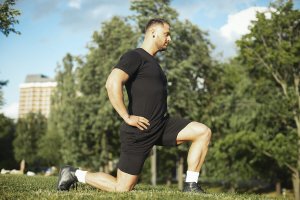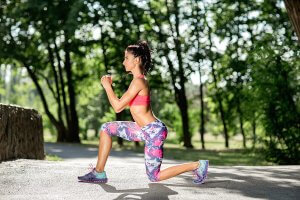Differences Between Static and Dynamic Lunges

Having strong legs and buttocks is very important for both athletes and amateurs. As we know, thighs are a fundamental part of our bodies that shouldn’t be overlooked in any training routine. If you want to tone your legs, we recommend you practice static and dynamic lunges.
Lunges are full-body exercises that engage your abdominal muscles at the same time that they engage the legs. In this article, we’ll explain the differences between static lunges and dynamic lunges. Plus, you will learn how you can benefit from these exercises by executing them differently.
Static and dynamic lunges: the importance of variability
The body has an amazing ability to adapt to exercise. Once this happens, exercise stops being as effective as it once was. To avoid that, it’s very important to change your routines every once in a while.
Because we know shaking up your routines is very important, we recommend you include static and dynamic lunges. Of course, this is a great way to avoid monotony and boredom when training and is incredibly important to keep motivation up. As we’ll see below, although both activate and work the same muscle groups, each type of lunge places more emphasis on certain areas.
Static and dynamic lunges within a routine
As mentioned earlier, lunges affect both the muscular development of the legs and the strengthening of our hips. In most cases, lunges engage the following joints:
- Knee joints: knees are deeply involved when you lunge because your quadriceps tense and your knees bend.
- Hip joints: hips engage the gluteal muscles and the femoral area, providing stability.

If you look closely, the muscles involved are the same as when you squat. However, by striding forward or backward, lunges make it possible to achieve greater gluteal and femoral activation.
The muscles around our hips, mainly the adductors and abductors, are often overlooked in training routines. Despite their great importance for your body, as your body’s stability depends on them, these muscles become neglected during workouts.
In order to enrich our training routines, you have to understand how the static and dynamic lunges differ from one another.
Static lunges vs. dynamic
To analyze the two types of lunges, we’ll explain the differences when executing the exercise, as well as which muscles are involved in each one.
Differences at the execution level
When you lower your body in the static lunge, the energy concentrates in the gluteal muscles, as well as the quadriceps and the femoral muscles. This will allow these muscles to grow stronger. As you can feel when you execute the lunge, most of the weight of your body falls on the leg in front of you. Meanwhile, the leg to your back provides support and balance to keep your body aligned and well-rooted.
When you go up again, the gluteal muscles, femoral muscles, and quadriceps work in a concentric way, which allows the thighs to stretch while returning to the starting point. To lift your body, the leg to your back contracts and your gluteal muscles take most of the strain.
On the other hand, dynamic lunges work in a slightly different way. While the descent works exactly the same as in the static lunge, lifting up your body is slightly different.
While static lunges mostly engage the gluteal muscles, dynamic lunges engage the quadriceps. Many professional trainers even say that static lunges are similar to one-leg squats. When going up, you have to tense your quadriceps in order to get your feet back together.
Dynamic lunges should be executed in a linear direction, always going forward and keeping your knee above your ankle to avoid injuries.

Differences related to the involvement of muscles
Both static and dynamic lunges engage the same muscle groups. However, depending on the type of lunges, more emphasis will be placed on one area or another.
- Static lunges: when going down, the front leg works harder, especially the gluteal muscles and the quadriceps. When going up, the front leg is also the one working harder.
- Dynamic lunges: the muscles engaged when going down are similar to those you use in the static lunge. However, when going up, the gluteal muscles in both legs will be the muscles that work harder.
Now you know the main differences between static and dynamic lunges, start mixing them in your training routines!
Having strong legs and buttocks is very important for both athletes and amateurs. As we know, thighs are a fundamental part of our bodies that shouldn’t be overlooked in any training routine. If you want to tone your legs, we recommend you practice static and dynamic lunges.
Lunges are full-body exercises that engage your abdominal muscles at the same time that they engage the legs. In this article, we’ll explain the differences between static lunges and dynamic lunges. Plus, you will learn how you can benefit from these exercises by executing them differently.
Static and dynamic lunges: the importance of variability
The body has an amazing ability to adapt to exercise. Once this happens, exercise stops being as effective as it once was. To avoid that, it’s very important to change your routines every once in a while.
Because we know shaking up your routines is very important, we recommend you include static and dynamic lunges. Of course, this is a great way to avoid monotony and boredom when training and is incredibly important to keep motivation up. As we’ll see below, although both activate and work the same muscle groups, each type of lunge places more emphasis on certain areas.
Static and dynamic lunges within a routine
As mentioned earlier, lunges affect both the muscular development of the legs and the strengthening of our hips. In most cases, lunges engage the following joints:
- Knee joints: knees are deeply involved when you lunge because your quadriceps tense and your knees bend.
- Hip joints: hips engage the gluteal muscles and the femoral area, providing stability.

If you look closely, the muscles involved are the same as when you squat. However, by striding forward or backward, lunges make it possible to achieve greater gluteal and femoral activation.
The muscles around our hips, mainly the adductors and abductors, are often overlooked in training routines. Despite their great importance for your body, as your body’s stability depends on them, these muscles become neglected during workouts.
In order to enrich our training routines, you have to understand how the static and dynamic lunges differ from one another.
Static lunges vs. dynamic
To analyze the two types of lunges, we’ll explain the differences when executing the exercise, as well as which muscles are involved in each one.
Differences at the execution level
When you lower your body in the static lunge, the energy concentrates in the gluteal muscles, as well as the quadriceps and the femoral muscles. This will allow these muscles to grow stronger. As you can feel when you execute the lunge, most of the weight of your body falls on the leg in front of you. Meanwhile, the leg to your back provides support and balance to keep your body aligned and well-rooted.
When you go up again, the gluteal muscles, femoral muscles, and quadriceps work in a concentric way, which allows the thighs to stretch while returning to the starting point. To lift your body, the leg to your back contracts and your gluteal muscles take most of the strain.
On the other hand, dynamic lunges work in a slightly different way. While the descent works exactly the same as in the static lunge, lifting up your body is slightly different.
While static lunges mostly engage the gluteal muscles, dynamic lunges engage the quadriceps. Many professional trainers even say that static lunges are similar to one-leg squats. When going up, you have to tense your quadriceps in order to get your feet back together.
Dynamic lunges should be executed in a linear direction, always going forward and keeping your knee above your ankle to avoid injuries.

Differences related to the involvement of muscles
Both static and dynamic lunges engage the same muscle groups. However, depending on the type of lunges, more emphasis will be placed on one area or another.
- Static lunges: when going down, the front leg works harder, especially the gluteal muscles and the quadriceps. When going up, the front leg is also the one working harder.
- Dynamic lunges: the muscles engaged when going down are similar to those you use in the static lunge. However, when going up, the gluteal muscles in both legs will be the muscles that work harder.
Now you know the main differences between static and dynamic lunges, start mixing them in your training routines!
All cited sources were thoroughly reviewed by our team to ensure their quality, reliability, currency, and validity. The bibliography of this article was considered reliable and of academic or scientific accuracy.
- Longpré, H. S., Acker, S. M., & Maly, M. R. (2015). Muscle activation and knee biomechanics during squatting and lunging after lower extremity fatigue in healthy young women. Journal of Electromyography and Kinesiology, 25(1), 40-46.
- Stastny, P., Lehnert, M., Zaatar, A. M., Svoboda, Z., & Xaverova, Z. (2015). Does the Dumbbell-Carrying Position Change the Muscle Activity in Split Squats and Walking Lunges?. Journal of strength and conditioning research, 29(11), 3177.
This text is provided for informational purposes only and does not replace consultation with a professional. If in doubt, consult your specialist.








